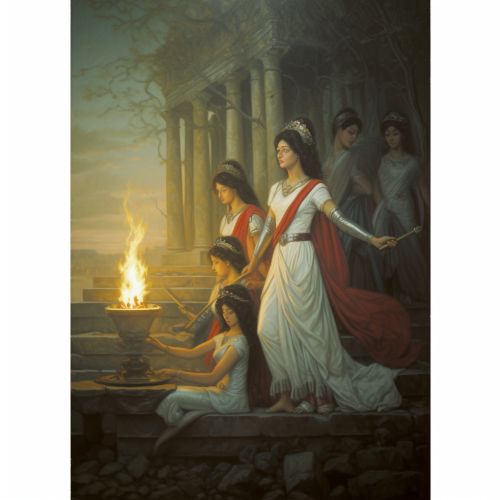Vestal Virgin
Introduction
The Vestal Virgins were a group of six women in ancient Rome who were chosen to serve as priestesses of Vesta, the goddess of the hearth and home. They were selected from noble families at a young age, usually between six and ten years old, and were required to serve for a period of thirty years. During this time, they were expected to maintain a vow of chastity and were tasked with the important duty of maintaining the sacred fire of Vesta.


Selection and Training
The selection process for the Vestal Virgins was rigorous and highly selective. The Pontifex Maximus, or chief priest, would choose from a group of twenty girls presented by their families. The chosen girls needed to be free of physical and mental defects, have two living parents, and be free from any family curse. Once chosen, the girls were taken from their families and entrusted to the care of the older Vestal Virgins for their training. They were taught the rituals and duties that they would need to perform, including the maintenance of the sacred fire, the preparation of ritual food, and the proper conduct of various religious ceremonies.
Duties and Responsibilities
The primary duty of the Vestal Virgins was to maintain the sacred fire of Vesta. This fire was considered to be the heart of Rome, and its extinction was seen as a dire omen. In addition to this, the Vestals were responsible for the preparation of the mola salsa, a sacred mixture of salt and grain that was used in most Roman religious rituals. They also participated in various festivals and ceremonies throughout the year, such as the Vestalia, which was held in honor of Vesta.
Privileges and Restrictions
Despite the strict requirements of their position, the Vestal Virgins enjoyed a number of privileges that were unusual for women in ancient Rome. They were not under the control of their fathers or any other male relatives, and they were allowed to own property. They had a place of honor at public games and festivals, and they were even allowed to vote, a right that was typically reserved for men.
However, these privileges came with severe restrictions. The Vestals were required to remain celibate for the duration of their thirty-year term of service. Breaking this vow of chastity was considered to be an act of treason against Rome, and was punished by burial alive.
After Service
After their thirty-year term of service, the Vestal Virgins were free to leave the temple, marry, and live a normal life. However, many chose to remain in the temple for the rest of their lives, enjoying the privileges and respect that came with their position.
Legacy
The Vestal Virgins left a lasting legacy in Roman society and culture. They were revered as symbols of purity and dedication, and their service was seen as essential to the well-being of the city. The ruins of their temple can still be seen in the Roman Forum, serving as a reminder of their important role in ancient Roman religion.
